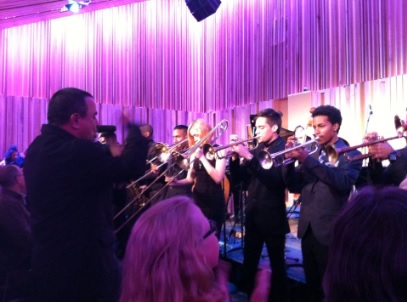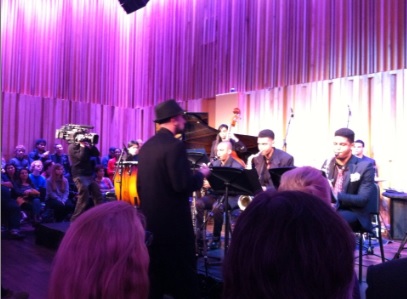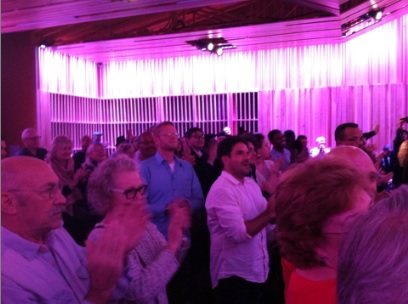Afro-Cuban culture, Blog, Cuban Jazz, Latin Jazz, The Cuba-US connection

Giovanni Russonello shines a light on two things we’ve been writing about a lot in recent years:
The sublime pleasures of Latin Jazz and the incredible new generation of players and composers who merit a lot more attention than they are currently getting.
This appeared in today’s (February 11, 2017) New York Times:
Latin Jazz is Booming. Look Beyond the Grammys to Find It.
By Giovanni Russonello
When the Grammy Awards eliminated the category of best Latin jazz album six years ago, an outcry arose quickly. Musicians and advocates argued that the move cut off a rare source of institutional recognition for a genre at the commercial fringes. And the academy listened. The next year the category returned.
In the years since, the importance of that recognition has become even clearer: Latin jazz is experiencing a kind of creative bloom, with musicians diversifying their work at an uncommon clip. It’s generating some of the most invigorating improvised music around.
So maybe it is a bit disappointing that the Grammy nominations this year don’t fully reflect those developments, focusing instead on older musicians. Every nominee up for best Latin jazz album this Sunday is over 60.
More: https://www.nytimes.com/2017/02/10/arts/music/grammys-latin-jazz.html?_r=0
– Ken McCarthy
Jazz on the Tube
P.S. Our unique programming is made possible by help from people like you. Learn how you can contribute to our efforts here: Support Jazz on the Tube
Thanks.

Blog, Cuba, Cuban Jazz, Latin Jazz, The Cuba-US connection, Video and audio
New Orleans and Havana have a long history together.
For a while (1762 to 1802) when Louisiana (“Luisiana” in Spanish) was a Spanish holding, New Orleans was administered by Havana and the Spanish left behind many beautiful buildings.
Much of the French Quarter was actually built by the Cubans after a catastrophic fire destroyed most of the old city in 1788.
U.S. troops about to enter the Spanish-American War, which included the liberation of Cuba from Spanish control, shipped out of New Orleans and returned there (which is why New Orleans was full of used brass instruments around the turn of the century.)
Also, several members of important community brass bands were part of the force that invaded and then occupied Havana after the war. You can be sure they brought back some Cuban feel from the experience.
Dave Bartholomew, the New Orleanian who put his formative stamp on rock ‘n roll in the late 1940s, says he got the riff from his iconic “Country Boy” (used later on thousands of rock tunes including Elvis Presley’s “Hound Dog”) from a Cuba Son record.
And on and on it goes.
The history continued in January of 2017 with a visit by high school jazz students from Havana to New Orleans, the first such visit in at least 60 years (possibly the first such visit ever.)
The kids worked with musicians at Preservation Hall and gave a performance which was received enthusiastically by the city’s discriminating jazz fans.
In the captions below, we note the names of the Cuban educators who train and manage the band, two of the great unsung heroes in the Horns to Havana organization: Enrique Toledo and Camilo Moreira.
 Orchestra Director Enrique Toledo
Orchestra Director Enrique Toledo
 Camilo Moreira conducts
Camilo Moreira conducts
 Standing ovation in New Orleans for the kids from Cuba
Standing ovation in New Orleans for the kids from CubaEnrique Toledo conducts the Conservatorio Amadeo Roldán Jazz Orchestra in Havana, January 2016.
– Ken McCarthy
Jazz on the Tube
P.S. Our unique programming is made possible by help from people like you. Learn how you can contribute to our efforts here: Support Jazz on the Tube
Thanks.
Afro-Cuban culture, Blog, Cuba, Cuban Jazz, The Cuba-US connection, Video and audio
Steve Coleman in Matanzas (2017) with members of Rumba Timba. The group is made up of some of the younger members of Los Muñequitos de Matanzas. Luis Cancino Morales on the bells.
2016 marked Steve Coleman’s 20th year of exploring and playing in Cuba.
It all started with Coleman’s interest in the philosophical underpinnings of music and how complex cultural ideas are transmitted through music.
Anyone interested in this subject has to look to Africa and anyone in North America interested in African culture would do well to take a prolonged trip to Cuba.
Why Cuba?
For one thing it’s closer, but more importantly for historical reasons the concentration and variety of African cultural systems in Cuba is unprecedented anywhere on earth – even in Africa itself.
Coleman’s first visit to Cuba was in January 1996 where he wisely went straight to Mantazas one of the wellsprings of Afro-Cuban Culture.
This was followed up by a twelve day long collaboration in Havana with AfroCuba de Matanzas in February of the same year.
This initial collaboration culminated in a performance at the Havana Jazz Festival and a recording session at Egrem which produced the album “The Sign and The Seal by Steve Coleman and The Mystic Rhythm Society.
Here’s a documentary shot during the years right before Coleman went to Cuba (1993 to 1995).
In addition to being a composer, band leader, and instrumentalist, Coleman is also an educator.
– Ken McCarthy
Jazz on the Tube
P.S. Our unique programming is made possible by help from people like you. Learn how you can contribute to our efforts here: Support Jazz on the Tube
Thanks.
Afro-Cuban culture, Blog, Cuba, Cuban Jazz, Latin Jazz, The Cuba-US connection, Video and audio
It’s billed as “the largest celebration of Cuban culture in the U.S. since the 1950’s” – and it may well be true.
This year’s New Orleans Jazz Fest will include over 150 Cuban musicians, artists and craftsman, a large number of whom will be visiting the United States for the very first time.
Events will be at the Cultural Exchange Pavilion.
Performances on the Cuban Stage every day from 11:30 AM to 5:30 PM
Friday, April 28
The Pedrito Martinez Group
Septeto Nacional Ignacio Piñeiro of Cuba
Grupo Caury of Cuba
Saturday, April 29
Septeto Nacional Ignacio Piñeiro of Cuba
Grupo Caury of Cuba
Telmary y Habana Sana of Cuba
The Pedrito Martinez Group
Conga Los Hoyos of Cuba
Abdullah Ibrahim (Not Cuban but don’t miss him!)
Sunday, April 30
Septeto Nacional Ignacio Piñeiro of Cuba
Telmary y Habana Sana of Cuba
Conga Los Hoyos of Cuba
Grupo Caury of Cuba
Lakou Mizik (Haiti)
Gente de Zona
Thursday, May 4
The Pedrito Martinez Rumba Project featuring Roman Diaz
Changüí Guantánamo of Cuba
Conga Los Hoyos of Cuba
Friday, May 5
The Pedrito Martinez Rumba Project featuring Roman Diaz
Adonis y Osain del Monte of Cuba
Changüí Guantánamo of Cuba
Saturday, May 6
Los Van Van
The Pedrito Martinez Rumba Project featuring Roman Diaz
Adonis y Osain del Monte of Cuba
Changüí Guantánamo of Cuba
Septeto Santiaguero of Cuba
Conga Los Hoyos of Cuba
Sunday, May 7
Chucho Valdes Quintet,
Adonis y Osain del Monte of Cuba
Daymé Arocena of Cuba
Septeto Santiaguero of Cuba
Changüí Guantánamo of Cuba
– Ken McCarthy
Jazz on the Tube
P.S. Our unique programming is made possible by help from people like you. Learn how you can contribute to our efforts here: Support Jazz on the Tube
Thanks.
Blog, Cuba, The Cuba-US connection, Video and audio
Filmed at Live at Wolf Trap in Virginia on August 8, 1993.
Everyone knows at least one Cuban song: “Guantanamera”
Why?
Because it’s beautiful – and because Pete Seeger worked so hard to put it on the global music map.
Seeger learned the song in 1962 from a Cuban musician named Hector Angulo from Santa Clara, Cuba who was working at a children’s summer camp in the Catkills.
He recorded it live at Carnegie Hall in 1963, the year after the Cuban Missile Crisis, and it appeared on his album “We Shall Overcome.”
Over the five plus decades that he performed it – it was one of ihs favorite songs – he encouraged his audiences to sing along and learn a little Spanish in the process.
A “Guantanamera” means a girl from the musical eastern Cuban city of Guantanamo. A “guajira” is a farmer-peasant girl. (A guajira is also a type of Cuban song.)
The song started life as “Guajira Guantanamera” and was written in 1932 by Joseíto Fernandez (1908 – 1979.)
In 1959, Julián Orbón, professor at the Manhattan School of Music where Angulo was a student, adapted stanzas from Cuban poet and revolutionary hero Jose Marti’s (1853-1895) poem “Versos Sencillos” (Simple Verses)
Others who recorded it include Joan Baez, Jose Feliciano, Los Lobos, Celia Cruz, The Sandpipers, Julio Iglesias, Gloria Estefan, and even Pitbull.
What about the rest of the words?
In honor of the great spirit Peter Seeger (1919 – 2014) who brought the song to worldwide attention, here we go.
Note: There are many variations. Here’s one:
Yo soy un hombre sincero
(I am a truthful man)
De donde crecen las palmas
(From this land of palm trees.)
Y antes de morirme quiero
(And before dying I want…)
Echar mis versos del alma
(to share these verses from my soul)
Mi verso es de un verde claro
(My verse is light green)
Y de un carmín encendido
(But it’s also flaming red)
Mi verso es un ciervo herido
(My verse is a wounded deer)
Que busca en el monte amparo
(Who seeks refuge in the mountain)
Cultivo una rosa blanca
(I cultivate a white rose)
En julio como en enero
(In June just just as in January)
Para el amigo sincero
(For the sincere friend)
Que me da su mano franca
(who gives me his hand)
Y para el cruel
(And for the cruel one…)
que me arranca el corazon con que vivo
(Who would tear out this heart with which I live)
Cardo ni ortiga cultivo
(I cultivate neither thistles nor nettles)
cultivo la rosa blanca
(I cultivate a white rose)
Con los pobres de la tierra
(With the poor people of the earth)
Quiero yo mi suerte echar
(I want to cast my lot)
El arroyo de la sierra
(The mountain stream)
Me complace más que el mar
(Gives me more pleasure than the sea)
Here’s the song performed by its composer, Joseíto Fernandez, his version, his original words.
Note the Cuban piano wizard who kicks in at 5:19.
If anyone knows who this might be, please drop me a line.
Update: Two independent sources say it’s Cheo Belén Puig.
– Ken McCarthy
Jazz on the Tube
P.S. Our unique programming is made possible by help from people like you. Learn how you can contribute to our efforts here: Support Jazz on the Tube
Thanks.
Afro-Cuban culture, Blog, Cuba, Cuban Jazz, Latin Jazz, The Cuba-US connection
 Cuban percussion master Cándido de Guerra Camero (“Candido”)
Cuban percussion master Cándido de Guerra Camero (“Candido”)
with Charlie Parker and Dizzy Gillespie in New York City in 1950A surprising number of hard core jazz fans have never seen this picture and would not be able to explain its historical context or significance.
– Ken McCarthy
Jazz on the Tube
P.S. Our unique programming is made possible by help from people like you. Learn how you can contribute to our efforts here: Support Jazz on the Tube
Thanks.








